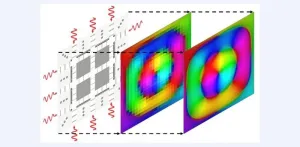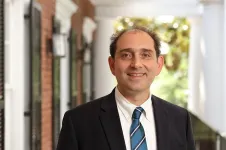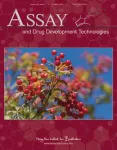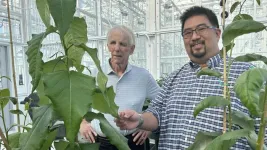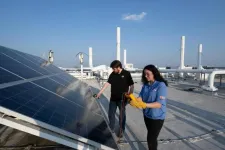(Press-News.org) In the fields of physics, mathematics, and engineering, partial differential equations (PDEs) are essential for modeling various phenomena, from heat diffusion to particle motion and wave propagation. While some PDEs can be solved analytically, many require numerical methods, which can be time-consuming and computationally intensive. To address these challenges, scientists have been exploring alternative computing paradigms, including photonic computing.
Photonic computing leverages light–matter interactions to perform high-speed calculations. A recent study from Newcastle University, published in Advanced Photonics Nexus, introduces a novel approach using electromagnetic (EM) waves to solve PDEs, specifically the Helmholtz wave equation. The researchers developed a network of interconnected waveguides filled with dielectric inserts, which mimics the behavior of traditional circuit elements.
This innovative structure, known as a metatronic network, effectively behaves like a grid of T-circuits. By adjusting the dimensions and permittivity of the dielectric inserts, the researchers demonstrated control over the parameters of the PDEs. This allows the network to solve various boundary value problems, such as EM wave scattering and light focusing.
Dr. Victor Pacheco-Peña, corresponding author for the report, highlights the potential of these devices as computational accelerators: “We envision that these devices may be used to produce fast approximate solutions for various partial differential equations,” he remarked, adding that this research represents a significant step forward in the field of analogue computing, as a promising way to rapidly and efficiently solve complex equations.
For details, see the original Gold Open Access article by R.G. MacDonald, A. Yakovlev, and V. Pacheco-Peña, “Solving partial differential equations with waveguide-based metatronic networks,” Adv. Photon. Nexus 3(5), 056007 (2024), doi 10.1117/1.APN.3.5.056007.
END
Photonic computing harnesses electromagnetic waves
New photonic computing method uses electromagnetic waves to solve partial differential equations rapidly
2024-10-18
ELSE PRESS RELEASES FROM THIS DATE:
Loss of ‘nitrogen fixers’ threatens biodiversity, ecosystems
2024-10-18
STARKVILLE, Miss.—Mississippi State University is part of a European-American collaboration studying how human activities, like fertilizer use and polluting, are impacting nitrogen-fixing plants which are crucial for maintaining healthy ecosystems by adding nitrogen to the soil.
MSU Assistant Professor Ryan A. Folk of the Department of Biological Sciences co-authored a study published today [Oct. 18] in Science Advances, showing that increased nitrogen deposition from human activity is reducing the diversity and evolutionary distinctiveness of nitrogen-fixing plants. Lead author Pablo Moreno García, ...
UH Energy Transition Institute launches radio show and online webinars focused on addressing grand challenges in energy
2024-10-18
HOUSTON, Oct. 18, 2024 –The University of Houston Energy Transition Institute is launching two educational series focused on exploring the unfolding energy transition and addressing the grand challenges in energy.
Starting October 21, "Driving the Energy Transition," will air on Houston Public Media’s KUHF News 88.7 with new episodes launching every two weeks on Mondays. The following day, October 22, the Energy Transition Webinar series will begin, running biweekly on ...
UVA professor tackles graph mining challenges with new algorithm
2024-10-18
University of Virginia School of Engineering and Applied Science professor Nikolaos Sidiropoulos has introduced a breakthrough in graph mining with the development of a new computational algorithm.
Graph mining, a method of analyzing networks like social media connections or biological systems, helps researchers discover meaningful patterns in how different elements interact. The new algorithm addresses the long-standing challenge of finding tightly connected clusters, known as triangle-dense subgraphs, within large networks — a problem that is critical in fields such as fraud detection, computational biology and data ...
Announcing the new editor-in-chief of ASSAY and Drug Development Technologies
2024-10-18
New Rochelle, NY, October 17, 2025—Mary Ann Liebert, Inc., is pleased that Wai Hong (Kevin) Lo, PhD, has been appointed the new Editor-in-Chief of the journal ASSAY and Drug Development Technologies. Dr. Lo is replacing Bruce Melancon, PhD as Editor-in-Chief.
ASSAY and Drug Development Technologies provides access to novel techniques and robust tools that enable critical advances in early-stage screening. This research published in the Journal leads to important therapeutics and platforms for drug discovery and development. This peer-reviewed journal features original papers application-oriented technology reviews, topical issues on ...
Finding could help turn trees into affordable, greener industrial chemicals
2024-10-18
EMBARGOED FOR RELEASE UNTIL 2 P.M. EDT ON FRIDAY, OCT. 18
Trees are the most abundant natural resource living on Earth’s land masses, and North Carolina State University scientists and engineers are making headway in finding ways to use them as sustainable, environmentally benign alternatives to producing industrial chemicals from petroleum.
Lignin, a polymer that makes trees rigid and resistant to degradation, has proven problematic. Now those NC State researchers know why: They’ve identified the ...
UTA to host discussion on Texas energy needs
2024-10-18
The University of Texas at Arlington will host GridNEXT DFW 2024: Meeting the Demand, an event dedicated to envisioning the future of energy infrastructure, on Oct. 25 from 9 a.m. to 3 p.m.
The one-day seminar will bring together industry partners, leaders, government officials and private stakeholders across the Texas energy space to discuss growing power needs and how to better support the Texas power grid.
It will be held at UTA’s Rio Grande Ballroom, 300 W. First St. in Arlington. Woody Rickerson, ERCOT senior vice ...
Preventive medicine professors part of collaborative grant for AI system to enhance Alzheimer's caregiving
2024-10-18
Jennifer Martindale-Adams, EdD, and Linda Nichols, PhD, professors in the Department of Preventive Medicine in the College of Medicine at the University of Tennessee Health Science Center, are members of a team led by Xiaopeng Zhao, PhD, professor in the Department of Mechanical, Aerospace, and Biomedical Engineering at the University of Tennessee, Knoxville, that was recently awarded $401,090 grant from the National Institute on Aging for the development of the RISE project, “Robot-based Information and Support to Enhance Alzheimer’s Caregiver ...
Tropical mammals react to changes in lunar light
2024-10-18
The full moon has a bad reputation for bringing out the worst in people, from werewolves to lunatics. However, it turns out that the lunar cycle can impact behavior – at least in tropical mammals.
New research appearing in the Proceedings of the Royal Society B reveals that half of the mammal species in tropical forests adjust their behaviors in response to the moon's phases and corresponding variations in light.
By Caleb Hess, Cathrine Glosli
Michigan State University ecologist Lydia Beaudrot, who studies tropical ecology and conservation, was among the international cohort of researchers who contributed to the study. ...
Pennington Biomedical’s EAT2 study to explore unknown effects of weight fluctuations
2024-10-18
Dr. Ursula White, an associate professor of Clinical Science at Pennington Biomedical Research Center, is taking a deep dive into the lasting health effects of short-term weight gain and weight loss. The ability for the fat tissue to expand or contract to accommodate changes in body weight is important for sustained health. Dr. White’s clinical study at Pennington Biomedical, the EAT2 study, will allow her to explore how changes within the adipose tissue are affected by weight gain and weight loss, and what that means for a person’s health.
The EAT2 study is recruiting participants now, and participants will be randomly assigned ...
Butterfly brains reveal the tweaks required for cognitive innovation
2024-10-18
A species of tropical butterfly with unusually expanded brain structures display a fascinating mosaic pattern of neural expansion linked to a cognitive innovation.
The study, published today in Current Biology, investigates the neural foundations of behavioural innovation in Heliconius butterflies, the only genus known to feed on both nectar and pollen. As part of this behaviour, they demonstrate a remarkable ability to learn and remember spatial information about their food sources—skills previously connected to the expansion of a brain structure called the mushroom bodies, responsible for learning and memory.
Lead author Dr Max ...
LAST 30 PRESS RELEASES:
Numbers in our sights affect how we perceive space
SIMJ announces global collaborative book project in commemoration of its 75th anniversary
Air pollution exposure and birth weight
Obstructive sleep apnea risk and mental health conditions among older adults
How talking slows eye movements behind the wheel
The Ceramic Society of Japan’s Oxoate Ceramics Research Association launches new international book project
Heart-brain connection: international study reveals the role of the vagus nerve in keeping the heart young
Researchers identify Rb1 as a predictive biomarker for a new therapeutic strategy in some breast cancers
Survey reveals ethical gaps slowing AI adoption in pediatric surgery
Stimulant ADHD medications work differently than thought
AI overestimates how smart people are, according to HSE economists
HSE researchers create genome-wide map of quadruplexes
Scientists boost cell "powerhouses" to burn more calories
Automatic label checking: The missing step in making reliable medical AI
Low daily alcohol intake linked to 50% heightened mouth cancer risk in India
American Meteorological Society announces Rick Spinrad as 2026 President-Elect
Biomass-based carbon capture spotlighted in newly released global climate webinar recording
Illuminating invisible nano pollutants: advanced bioimaging tracks the full journey of emerging nanoscale contaminants in living systems
How does age affect recovery from spinal cord injury?
Novel AI tool offers prognosis for patients with head and neck cancer
Fathers’ microplastic exposure tied to their children’s metabolic problems
Research validates laboratory model for studying high-grade serous ovarian cancer
SIR 2026 delivers transformative breakthroughs in minimally invasive medicine to improve patient care
Stem Cell Reports most downloaded papers of 2025 highlight the breadth and impact of stem cell research
Oxford-led study estimates NHS spends around 3% of its primary and secondary care budget on the health impacts of heat and cold in England
A researcher’s long quest leads to a smart composite breakthrough
Urban wild bees act as “microbial sensors” of city health.
New study finds where you live affects recovery after a hip fracture
Forecasting the impact of fully automated vehicle adoption on US road traffic injuries
Alcohol-related hospitalizations from 2016 to 2022
[Press-News.org] Photonic computing harnesses electromagnetic wavesNew photonic computing method uses electromagnetic waves to solve partial differential equations rapidly
